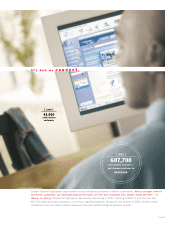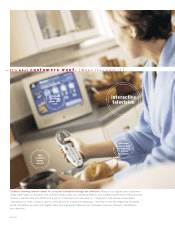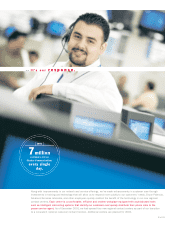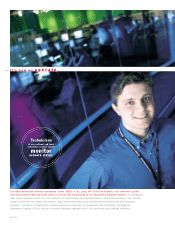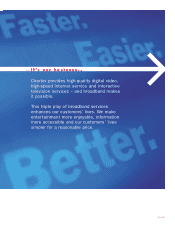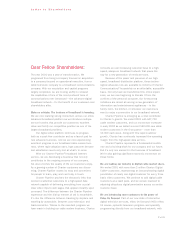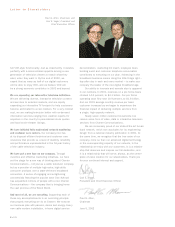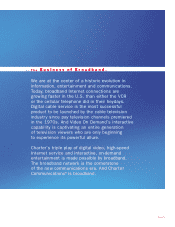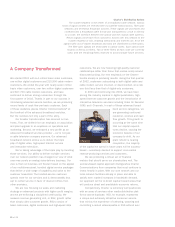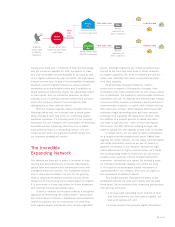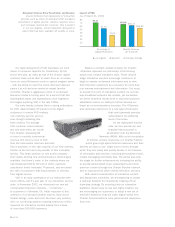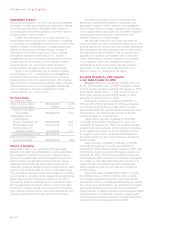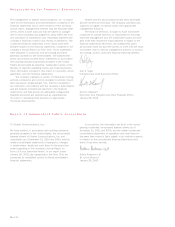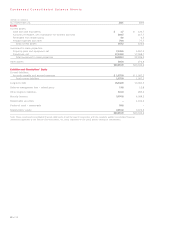Charter 2001 Annual Report Download - page 13
Download and view the complete annual report
Please find page 13 of the 2001 Charter annual report below. You can navigate through the pages in the report by either clicking on the pages listed below, or by using the keyword search tool below to find specific information within the annual report.
11 of 25
leaving your living room. Confident of both the technology
and the consumer appetite for VOD, we expect to make
this truly remarkable service available to as many as half
of our digital customers by year end 2002. Our high-speed
Internet service sets us apart from competitive broadband
providers. Charter Pipeline®delivers a robust customer
experience at very affordable prices and is available at
tiered speeds so customers choose the speed best suited
to their needs. And our interactive television portfolio
includes a mix of carefully selected content and services,
some of it unique to Charter Communications, that
distinguishes us from other providers.
With our network upgrade nearly complete and our
financing needs met, our business now is about gener-
ating increased cash flow while our underlying capital
expenses decrease. It’s a turning point for our company
financially. For our investors, the combination of declining
expenditures and increasing cash flow from a stable,
loyal customer base is a compelling reward. It is the
model around which our capital investment policy and
our business strategy will revolve.
The Incredible
Expanding Network
The network we have put in place is a marvel of engi-
neering and accomplishment. It blends high-capacity
optical fiber and coaxial cable transmission lines with
intelligent electronic devices. Our broadband network
sets in place the foundation not only for the growing
array of advanced broadband services we can deliver
today, but for future ideas we’ve barely begun to imagine.
It is structured in a way that allows for future expansion
with minimal incremental capital costs.
Charter’s network architecture reflects a thoughtful
approach to harnessing raw mathematics – particularly
the mathematics of division. Traditional communications
networks typically rely on a succession of wires that
push signals deeper and deeper from central origination
points. Although engineers can install enhanced elec-
tronics at the front and back ends of these networks
to expand capability, the wires in between are still the
same, and ultimately fall victim to physical laws that
limit their capacity.
To avoid these physical limitations, Charter
constructed a network of thousands of smaller, inter-
connected units, each outfitted with its own unique alloca-
tion of bandwidth, the capacity to accommodate electronic
information such as TV channels and Internet data. Instead
of one monolithic network, we literally have thousands of
interconnected networks, or nodes, each of them serving
500 customers or fewer. What happens when those 500
customers begin demanding more and more services,
requiring more capacity? We apply basic division. With
the addition of a modest amount of capital and labor,
one node is split into two – each of them serving not
500 homes, but 250. Without installing a single new
cable or optical line, the capacity of that node is doubled.
In simple terms, we are able to make modifications
on a neighborhood-by-neighborhood basis. Rather than
upgrade our entire network, we can apply minimal capital
and divide distribution nodes as we see fit, based on
patterns of demand. If, for instance, demand for high-
speed data service is high in certain areas, we’ll divide
the corresponding nodes to make sure we can accom-
modate every customer without compromising other
customers’ connectivity and speed. By dividing a node,
we increase bandwidth capacity only where we need
it. This type of success-based capital deployment is
unprecedented in our industry, and owes its origins to
the node-based broadband network.
This simple example illustrates the power of the
broadband network we have put in place over the past
three years. We’ve combined this underlying architecture
with two key elements:
• A two-way path consisting of six strands of fiber
that lets customers not only receive signals, but
also send signals out; and
• In-home devices that process digital information.
Primary
Hub
Satellite
sends data
to Master
Headend
Serves areas from
5,000 to 300,000+
customers
Master
Headend
Master
Headend
Master
Headend
Serves 20,000
or more customers
Fiber optic lines
Fiber optic lines Coaxial cable
Coaxial cable
Fiber
optic
lines
Serves fewer than
20,000 customers
Node
Node
Node
Serves
maximum of
500 customers
Serves
maximum of
500 customers
Secondary
Hub
Secondary
Hub
Secondary
Hub
Node


